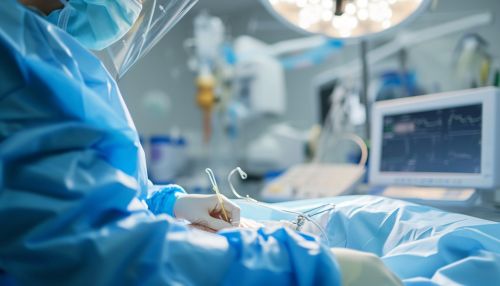Elastography
Introduction
Elastography is a medical imaging modality that maps the elastic properties and stiffness of soft tissue. This technique can be used in various medical procedures to detect abnormalities in tissues that may be indicative of diseases such as cancer. Elastography provides information about the mechanical properties of tissue, a feature that other imaging techniques such as CT, MRI, and ultrasound do not provide.


History
The concept of elastography was first introduced in the late 20th century. The initial idea was to use ultrasound to measure the stiffness of tissues, a property that could potentially differentiate healthy from diseased tissue. The first elastography systems were based on quasistatic techniques, which are still in use today.
Techniques
There are several types of elastography techniques, each with its own advantages and disadvantages. These include:
- Quasistatic Elastography: This technique involves applying a slow, manual compression to the tissue and using ultrasound to track the resulting tissue displacement. The strain (or deformation) in the tissue is then calculated and used to generate an elastogram.
- Dynamic Elastography: In this technique, a dynamic, oscillatory stress is applied to the tissue. The resulting wave propagation is measured using ultrasound or MRI, and the wave speed is used to calculate the tissue's shear modulus, a measure of its stiffness.
- Shear Wave Elastography: This technique uses an acoustic radiation force to generate shear waves in the tissue. The speed of these waves is then measured using ultrasound or MRI, and this speed is directly related to the tissue's shear modulus.
- Acoustic Radiation Force Impulse Imaging (ARFI): This is a type of shear wave elastography where the acoustic radiation force is used to generate a localized, transient shear wave. The speed of this wave is then measured to calculate the tissue's stiffness.
Applications
Elastography has a wide range of applications in the medical field. Some of these include:
- Breast Imaging: Elastography can be used in conjunction with mammography to improve the detection and diagnosis of breast cancer. Tumors typically have a higher stiffness compared to healthy tissue, making them easier to detect with elastography.
- Liver Imaging: Elastography can be used to non-invasively assess liver fibrosis, a condition that can lead to cirrhosis and liver cancer. This technique can be used to monitor the progression of the disease and the effectiveness of treatment.
- Thyroid Imaging: Elastography can be used to differentiate benign from malignant thyroid nodules, reducing the need for unnecessary biopsies.
- Prostate Imaging: Elastography can be used in conjunction with ultrasound to improve the detection and diagnosis of prostate cancer.
Limitations and Challenges
While elastography has shown promise in various medical applications, there are several limitations and challenges that need to be addressed. These include:
- Operator Dependence: The quality of elastography images can be highly dependent on the operator's skill and experience. This can lead to variability in the results.
- Tissue Anisotropy: The mechanical properties of tissues can vary depending on the direction of the applied stress. This can complicate the interpretation of elastography images.
- Depth Limitation: The ability of elastography to accurately measure tissue stiffness decreases with depth. This can limit its use in imaging deep tissues.
- Motion Artifacts: Patient motion can cause artifacts in elastography images, affecting their quality and accuracy.
Future Directions
Despite these challenges, the future of elastography looks promising. Advances in technology and imaging algorithms are expected to improve the accuracy and reliability of elastography. Furthermore, the development of 3D elastography, which provides a three-dimensional view of the tissue's mechanical properties, is expected to expand the applications of this technique.
